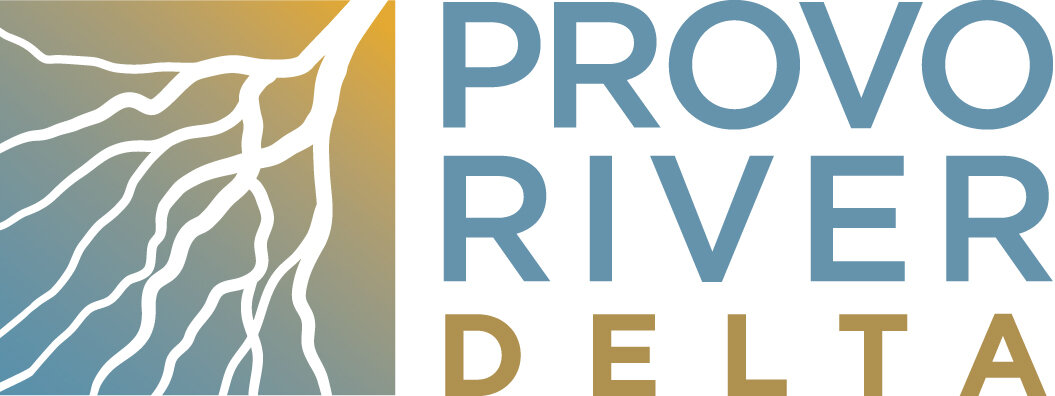Provo River Delta Restoration Project
2020 Groundbreaking Year In Review
Delta pond and channel excavation. October 2020
Ground is Broken on New Provo River Delta!
On June 11, 2020, after over a decade of planning and coordination, the first scoop of dirt was taken to break ground on the system of braided waterways and wetlands into which the last mile and a half of lower Provo River will be diverted as part of the Provo River Delta Restoration Project. This constructed delta will provide the environs for Utah Lake and Provo River flows to meet and mingle and will provide essential habitat for survival of June sucker in an effort to recover the endangered fish. With sensitivity to COVID-19 concerns, the groundbreaking celebration was recorded and released to the public as a virtual event. Among others, speakers includeed Utah Governor Gary Herbert, Utah County Commissioners Bill Lee and Nathan Ivie, and Chair of the Utah Reclamation Mitigation Commission Brad Barber.
Delta Begins to Take Shape
Standing at the edge of one of the newly constructed delta ponds, it’s becoming easier to visualize the diverse mix of habitats that will develop once the Provo River Delta Restoration Project is complete. In the months since excavation started, the western portion of the project area has been transformed from flat pastureland into an assortment of deep ponds, wide channels, and elevated riparian mounds. Dry conditions last summer and fall were ideal for excavation and hauling. More than 60,000 cubic yards of material – the equivalent of 28 football fields - were excavated from the project area and hauled to the future site of Provo City’s Regional Sports Park. We also focused on weed control and native plant restoration this year. Despite being shorthanded due to the pandemic, Utah Division of Wildlife Resources made great strides in knocking back noxious weeds like phragmites. Also last Fall, we spread seed on disturbed areas and installed 30,000 native plants.
Bird Monitoring Continues
The Provo River Delta Restoration Project area provides abundant habitat for many bird species. Because of the proximity of the project to the Provo Airport, there is a concern that altering habitats within the project area could change the number, timing and pattern of bird use and potentially increase the risk to aviation safety. To better understand how altering habitats within the project area could change the number, timing and pattern of bird use, a bird monitoring and movement study began in April 2017.
Brigham Young University, Department of Wildlife and Wildlands Conservation has been providing expertise and assistance in implementing the study. Twenty-two different monitoring sites are monitored three times per week (once in the morning, once in the afternoon and once in the evening) for a period of 10 minutes at each site. Trained observers identify bird species, numbers, location, habitat use, flight elevation, direction of flight and other data to better understand bird abundance and movement patterns. The monitoring and movement study will provide baseline data to identify any increased risk to aviation safety resulting from the project and will inform recommendations for mitigation if required.
To date, over 5,000 person hours have been spent monitoring birds from the 22 monitoring sites. Over 60,000 observations have been recorded and over 1,000,000 birds have been counted!
While the delta project area provides habitat for a rich diversity of species (167 different species were observed in the first three years), 80% of the 1,050,000 observations belonged to just four different guilds: starlings/blackbirds (277,784), swallows (230,238), waterfowl (174,425), gulls (163, 636). The total number of birds observed from one year to the next changed dramatically over the first three years: year1 (310,014), year2 (451,890 +31%), year3 204,514 (-121%). These changes could likely be tied in part to changes in available food resources and habitat over that period (Utah Lake marina dredging and high Utah lake levels).
Reaching Out - Safely
Required supplies included masks, hand sanitizer, and social distancing signs, but despite these challenges we managed to continue reaching out to stakeholders and the community this year. Although many of our usual outreach events like the Utah Lake Festival were canceled, we did some “distanced tabling” at a nearby trailhead and small site tours with interested parties, including Utah Lake Commission board members and teachers at nearby Provo High School. We also took advantage of virtual technology. We had to get innovative to celebrate the official delta groundbreaking last June.
We organized our first community volunteer event in October. Armed with masks, gloves, shovels (and a 2-meter space cushion), families yanked and pried out hundreds of young Russian Olives in our project area. Removal of these invasive trees will allow native cottonwoods and other plants more growing room, while avoiding herbicide use in a sensitive wetland area. Many thanks go to our volunteers who could have been weeding their own yards but chose to spend the sunny last-chance summer Saturday stewarding our public lands!
COVID permitting, we hope to offer additional site tour and volunteer opportunities in 2021.








